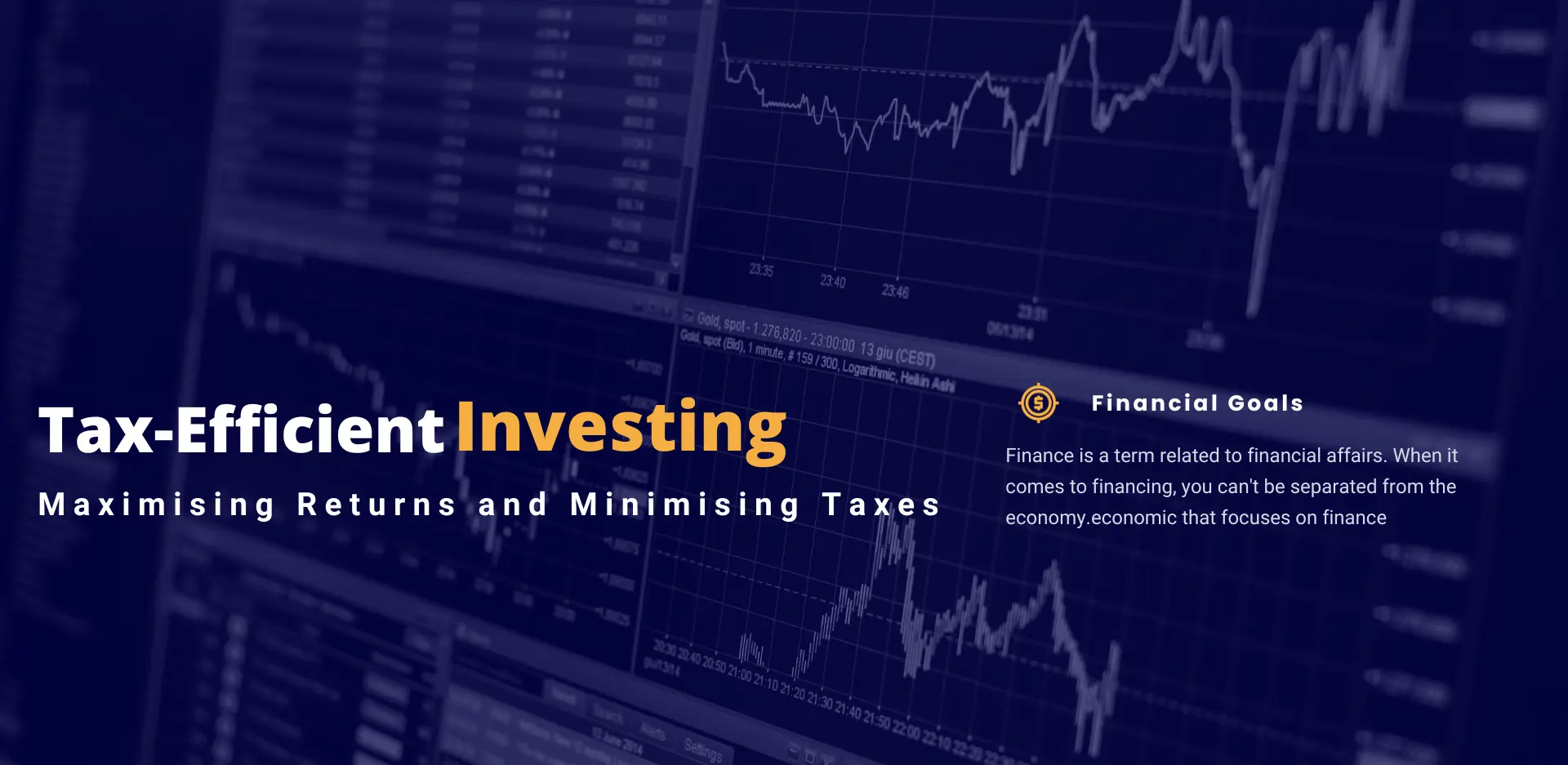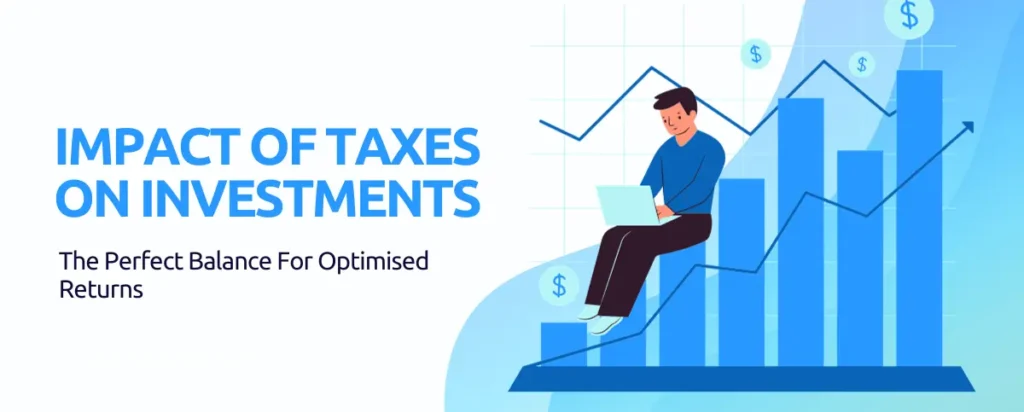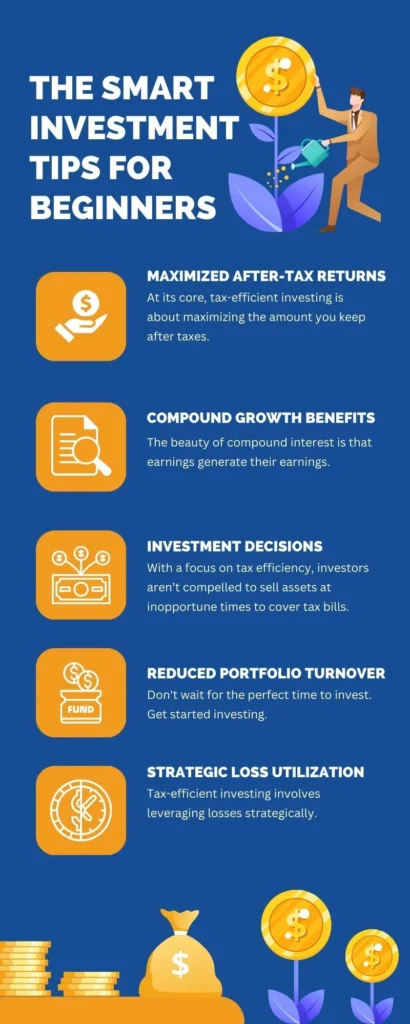
Tax-Efficient Investing: Maximising Returns and Minimising Taxes
Personal Finance and investing
- John Quarrie
- October 7, 2023
In investing, the quest for greater returns is a journey undertaken by every investor, from the novice to the seasoned. However, while most focus primarily on picking the right assets or timing the market, taxation is an often overlooked component that can significantly impact returns. Taxes, when not factored into an investment strategy, can erode returns and affect the overall growth of an investment portfolio. This brings to light the “Tax-Efficient Investing” concept—a strategic approach to maximize investment returns by minimizing the associated tax liabilities.
By understanding the intricate dance between taxes and investments, one can optimize their strategies to ensure that their hard-earned money works efficiently for them, yielding the best possible post-tax returns. This exploration will delve into the nuances of tax-efficient investing, providing insights into harmonizing financial growth with tax minimization
Investment and Taxation: The Perfect Balance for Optimised Returns
1. The Impact of Taxes on Investments:
Investments, whether in stocks, bonds, real estate, or other assets, are a primary way many individuals and institutions aim to grow their wealth. However, the returns from these investments are often not the sole determinant of their final value; taxes play a pivotal role. Taxes can considerably affect the net returns on investments. They can eat into profits, reduce yields, and, in some cases, even turn profitable investments into net losses after taxes. Thus, it’s not just about how much an investment earns but how much of that earning remains after taxes. Being mindful of these implications and planning investment strategies with taxes in mind can ensure wealth grows most efficiently. Understanding the tax implications on investments is crucial because they can significantly affect investors’ returns. Here’s a breakdown of how taxes impact various investments:

a. Capital Gains Tax:
When an investor sells an asset for more than they paid, the profit is considered a capital gain. Capital gains can be classified into short-term (typically assets held for a year or less) and long-term (assets held for more than a year). Each has its tax rate, with short-term capital gains generally taxing more than long-term ones.
b. Dividend Taxes:
Many stocks provide dividends, a portion of the company’s profits distributed to shareholders. These dividends are taxable. While some qualify for a lower tax rate, others are taxed at the investor’s ordinary income tax rate.
c. Interest Income:
Bonds and certain savings accounts yield interest income. This income is usually taxed at the investor’s ordinary income tax rate unless it’s from tax-free bonds like municipal bonds.
d. Tax on Real Estate:
Profits from selling real estate can also incur capital gains tax. Additionally, real estate properties might provide rental income, which is also subject to taxation. However, investors can often deduct property expenses, such as mortgage interest and maintenance costs, to reduce the taxable amount.
e. Tax-Deferred and Tax-Free Investment Accounts:
Certain investment accounts, like IRAs or 401(k)s in the U.S., allow for tax-deferred growth. This means investors don’t pay taxes on the returns yearly but only when they withdraw the funds. There are also Roth versions of these accounts where withdrawals can be tax-free under specific conditions.
f. Tax Efficiency of Funds:
Some mutual funds and ETFs are designed to be tax-efficient, meaning they employ strategies to minimize the tax liabilities for their shareholders. However, others might distribute significant taxable gains, impacting investors’ after-tax returns.
g. Tax-Loss Harvesting:
A strategic move where investors sell off assets that have incurred losses to offset the capital gains on other investments. This can effectively reduce the tax bill, but it’s essential to be aware of “wash sale” rules that prevent repurchasing the same or a substantially identical asset within 30 days before or after the sale.
2. Advantages of Tax-Efficient Investing:
Investing is replete with opportunities but also fraught with challenges, including taxation. Investors can leverage benefits that enhance their portfolio’s overall performance by optimizing for tax efficiency. Let’s dive deep into the advantages of tax-efficient investing:
Maximized After-Tax Returns:
At its core, tax-efficient investing is about maximizing the amount you keep after taxes. While gross returns are essential, the after-tax returns determine how much wealth you accumulate. Reducing tax liabilities ensures that a larger portion of your earnings stays in your pocket.
Compound Growth Benefits:
The beauty of compound interest is that earnings generate their earnings. When taxes are minimized, more money remains in the investment to compound over time. This leads to an exponential growth effect, where the difference between a tax-efficient and a non-tax-efficient portfolio can become vast over long periods.
Flexibility in Investment Decisions:
With a focus on tax efficiency, investors aren’t compelled to sell assets at inopportune times to cover tax bills. This provides the flexibility to make investment decisions based on market conditions and individual goals rather than tax constraints.
Reduced Portfolio Turnover:
Frequently buying and selling assets (often called “churning”) can lead to higher capital gains in the short term, which are often taxed at a higher rate. Tax-efficient investing promotes holding onto assets longer, reducing portfolio turnover and associated tax implications.
Optimized Allocation:
Tax-efficient investing encourages the placement of assets in accounts where they’ll be most tax-advantaged. For example, investments generating regular taxable income might be better suited for tax-advantaged accounts, while those with lower tax implications can be held in taxable accounts.

Enhanced Retirement Planning:
Many tax-advantaged accounts are designed specifically for retirement savings. By focusing on tax efficiency, investors can optimize their contributions to these accounts, ensuring they maximize their benefits in terms of investment returns and tax savings for their retirement years.
Strategic Loss Utilization:
Tax-efficient investing involves leveraging losses strategically. Through techniques like tax-loss harvesting, investors can offset gains with losses, effectively reducing their taxable income and ensuring that their overall portfolio remains balanced and aligned with their goals.
3. Strategies to Maximize Returns and Minimize Taxes:
Understanding and implementing tax-saving strategies can significantly boost the net returns on investments. Here’s a comprehensive look at some key tax-saving strategies and a guide on how to put them into action:
Explanation of Various Tax-Saving Strategies:
- Tax-Deferred Retirement Accounts: These accounts, like the IRA or 401(k), allow investments to grow without annual tax deductions. Taxes are only incurred upon withdrawal, typically during retirement when one may fall into a lower tax bracket.
- Tax-Loss Harvesting: This involves offsetting capital gains with capital losses from your investments, reducing your taxable income.
- Asset Location: The strategy of placing investments in the most appropriate type of account (taxable or tax-advantaged) based on their tax efficiency.
- Utilize Tax-Efficient Funds: Invest in funds with low turnover rates, like index funds or ETFs, which can be more tax-efficient due to fewer capital gains distributions.
- Gifting and Inheritance Strategies: Leveraging gift tax exemptions or trusts can reduce estate tax implications and efficiently transfer wealth.
- Diversification into Municipal Bonds: These bonds often offer tax-free interest at the federal (and sometimes state) level.
Step-by-Step Guide to Implementing These Strategies:
a. Open Tax-Advantaged Accounts:
- Research and open a retirement account suitable for your situation, like an IRA, 401(k), or similar instruments available in your region.
- Contribute regularly, ensuring the maximization of any employer matches or contributions.
b. Monitor and Identify Losses:
- Regularly review your portfolio.
- Identify assets that have depreciated. Consider selling these to realize the loss and offset against any gains.
c. Determine Asset Location:
- List down all your investments.
- Allocate tax-inefficient assets (like taxable bonds) to tax-advantaged accounts.
- Place tax-efficient assets (like index funds) in taxable accounts.
d. Choose Tax-Efficient Investments:
- Research and invest in tax-efficient funds, emphasizing those with low turnover rates.
- Be cautious of funds with high distributions if investing in a taxable account.
e. Strategize Gifting:
- Understand the annual gift tax exclusion limit.
- Consider gifting assets or money up to that amount to beneficiaries each year.
- Explore setting up trusts for more significant amounts or specific purposes.
f. Diversify with Municipal Bonds:
- Research municipal bonds available in your state or region.
- Consider adding them to your portfolio, especially if you’re in a higher tax bracket.
g. Consult a Tax Professional:
- Regularly consult with a tax advisor or financial planner to ensure you make the most tax-efficient decisions tailored to your situation.
4. Common Mistakes and How to Avoid Them:
Investing is not just about maximizing returns; it’s also about ensuring avoidable tax mistakes don’t unnecessarily reduce those returns. Here’s a detailed overview of frequent tax-related blunders and how you can circumvent them:
a. List of Frequent Tax-Related Mistakes Made by Investors:
- Overlooking Tax-Efficient Accounts: Many investors must take full advantage of tax-advantaged accounts, like IRAs, 401(k)s, and HSAs, which can lead to unnecessary tax liabilities.
- Ignoring the Impact of Turnover: High portfolio turnover can result in short-term capital gains, which are usually taxed at a higher rate than long-term gains.
- Not Utilizing Tax-Loss Harvesting: Investors sometimes don’t leverage the losses in their portfolio to offset gains, which can help reduce tax burdens.
- Misunderstanding Asset Location: Placing tax-inefficient assets in taxable accounts or vice versa can lead to avoidable tax consequences.
- Not Factoring in Mutual Fund Distributions: Buying mutual funds just before they make a distribution can lead to unexpected tax liabilities.
- Ignoring Gift and Estate Tax Rules: Please understand or leverage gift and estate tax exemptions to avoid unnecessary taxes or reduced wealth transfers.
- Lack of Diversification: Over-concentrating on one asset or type of investment can increase risk and potentially lead to higher tax consequences if that asset needs to be liquidated.
- Forgetting Required Minimum Distributions (RMDs): For certain retirement accounts, after reaching a specific age, one is required to start withdrawing a minimum amount. Failing to do so can result in hefty penalties.
b. Tips to Steer Clear of These Pitfalls:
- Maximize Tax-Advantaged Accounts: Regularly contribute to accounts like IRAs or 401(k)s and maximize any available matches or contributions.
- Opt for Low Turnover Investments: Choose index funds, ETFs, or other investments with low turnover to reduce the possibility of short-term capital gains.
- Regularly Review Your Portfolio: Schedule periodic portfolio reviews to identify opportunities for tax-loss harvesting and rebalance if necessary.
- Educate Yourself on Asset Location: Understand the tax implications of your investments and place them in the most tax-efficient accounts.
- Research Before Investing in Mutual Funds: Before purchasing mutual fund shares, check when the fund is set to make its next distribution to avoid unnecessary tax hits.
- Plan Wealth Transfers: Familiarize yourself with gift and estate tax rules and leverage trusts, gifting strategies, or other methods to optimize wealth transfers.
- Diversify Your Investments: Spread your investments across various asset classes and geographies to reduce risk and potential tax hits.
- Track and Meet RMD Deadlines: Set reminders or consult financial advisors to ensure you take the minimum distributions from retirement accounts.
Conclusion:
Tax-efficient investing is not just a strategy; it’s an essential facet of comprehensive financial planning. By understanding and harnessing the principles of tax-efficient investing, individuals can ensure that taxes do not unnecessarily erode their hard-earned returns. While the intricacies of tax codes and regulations can be daunting, the core strategies, such as leveraging tax-advantaged accounts, practising tax-loss harvesting, and smart asset location, can be applied universally.
However, investments and taxation continually evolve, and what works best today might change tomorrow. Thus, investors must stay informed, be adaptable, and, most crucially, consult with financial and tax professionals when making significant decisions. In doing so, investors can strike a balance between pursuing ambitious financial goals and ensuring that the largest possible portion of their investment returns remains in their pockets rather than being lost to taxes. After all, investing is not just about the money you make but also about the money you get to keep.
FAQs:
1. What is tax-efficient investing?
Tax-efficient investing is a strategy that focuses on maximizing investment returns by minimizing tax liabilities. It involves making investment decisions considering the tax implications to ensure investors retain the highest possible portion of their returns.
2. How does tax-efficient investing differ from regular investing?
While all investing aims to maximize returns, tax-efficient investing emphasizes reducing tax liabilities as a crucial strategy component. Regular investing may only consider the tax implications of buying or selling assets.
3. Why is tax-efficient investing important?
Taxes can significantly erode the returns on investments. By implementing tax-efficient strategies, investors can increase their after-tax returns, leading to more substantial growth in wealth over time.
4. What is a tax-advantaged account?
A tax-advantaged account is a type of investment account that offers tax benefits, either in the form of tax-deferred growth, tax-free withdrawals, or other tax incentives. Examples include IRAs, 401(k)s, and HSAs.
5. What is tax-loss harvesting?
Tax-loss harvesting is a strategy where investors sell securities that have incurred losses to offset capital gains from other investments, thereby reducing taxable income.
6. How does asset location contribute to tax efficiency?
Asset location involves placing investments in the most appropriate accounts (taxable or tax-advantaged) based on their tax efficiency. For example, placing tax-inefficient assets in tax-advantaged accounts can reduce overall tax liabilities.
7. Are all mutual funds tax-efficient?
No, not all mutual funds are tax-efficient. Funds with high turnover rates or frequent trades can result in higher capital gains distributions, leading to higher taxes for investors holding these funds in taxable accounts.
8. Can tax-efficient investing impact the overall risk of a portfolio?
While tax-efficient investing focuses on reducing tax liabilities, ensuring that the portfolio’s overall risk profile aligns with the investor’s risk tolerance and financial goals is essential. Tax considerations should maintain the primary investment objectives.
9. Is tax-efficient investing only for high-net-worth individuals?
No, tax-efficient investing can benefit investors at all wealth levels. Even modest tax savings can compound over time, leading to significant growth in wealth.
10. How often should I review my portfolio for tax efficiency?
It’s advisable to review your portfolio annually or after significant life changes. Regular check-ins with a financial advisor or tax professional can help maintain a tax-efficient investment approach.
Reference sites:
1. Internal Revenue Service (IRS):
- Website: www.irs.gov
- Description: The U.S. government agency responsible for tax collection and law enforcement. It details tax regulations, rules for different investment vehicles, and guides on various tax topics.
2. Investopedia:
- Website: www.investopedia.com
- Description: A comprehensive financial education website offering articles, tutorials, and educational content on various financial and investing topics, including tax-efficient strategies.
3. Morningstar:
- Website: www.morningstar.com
- Description: A well-known investment research firm that provides data on investment offerings, including mutual funds. They also have articles and tools related to tax-efficient investing.
4. Bogleheads:
- Website: www.bogleheads.org
- Description: An investing advice forum based on the principles of John Bogle, founder of Vanguard. The community often discusses tax-efficient investing strategies, among other topics.
5. The Tax Adviser:
- Website: www.thetaxadviser.com
- Description: This site offers expert insights and peer-reviewed articles on various tax topics, ensuring professionals and investors are updated with the latest tax strategies and regulations.
6. Charles Schwab:
- Website: www.schwab.com
- Description: As a leading brokerage firm, Charles Schwab provides a rich library of investment articles and research, including sections dedicated to tax-efficient strategies.
7. Fidelity Investments:
- Website: www.fidelity.com
- Description: Fidelity offers a wealth of information on its platform, with dedicated resources for understanding the tax implications of various investments.
8. Vanguard:
- Website: www.vanguard.com
- Description: Known for its low-cost index funds, Vanguard’s site also contains educational resources on tax-efficient investing.
9. The Motley Fool:
- Website: www.fool.com
- Description: A popular investment and finance site offering insights, advice, and resources related to investing, including the impacts of taxes on returns.
10. NerdWallet:
- Website: www.nerdwallet.com
- Description: This personal finance website offers articles, tools, and reviews about various financial topics, including investment and taxes.

